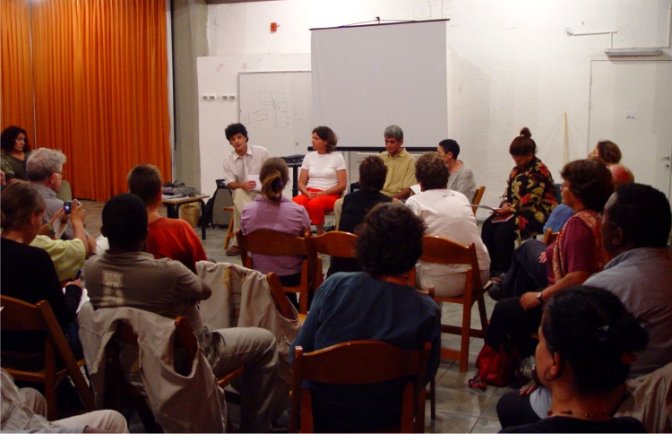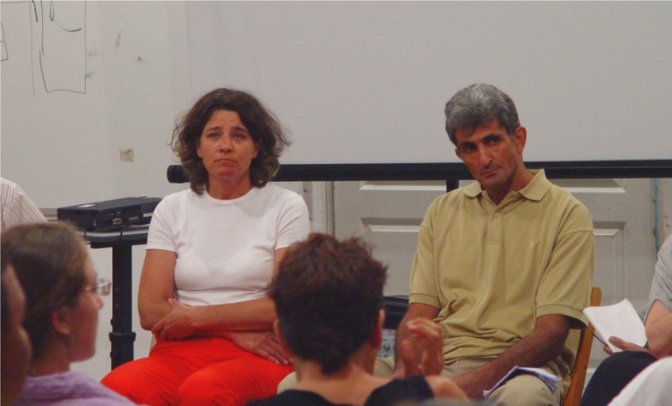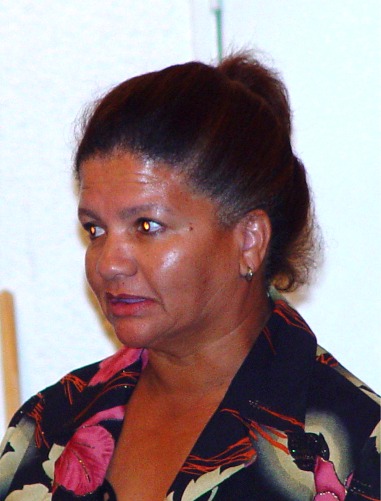Home > Oasis of Peace > Projects & Outreach > Doumia-Sakinah: The Pluralistic Spiritual Centre > Truth & Reconciliation: A screening of two documentaries and (...)
Truth & Reconciliation: A screening of two documentaries and discussion
Wednesday 6 July 2005
All the versions of this article: [عربي] [English] [עברית]

With a screening of two films and contributions by a large panel of speakers, we had the rare opportunity to confront the subject of reconciliation directly, through personal stories of people who refuse to remain as victims and choose to deal courageously with the possibilities of forgiveness, understanding and reconciliation.
In the first part of the program, we viewed the documentary My Terrorist (2002), directed by Julie Cohen Gershtal. In the film, Julie attempts to reconcile with the terrorist who injured her 23 years ago in a terror bombing and who remains in a British jail. The film, which won international acclaim, is one of a trilogy of autobiographical films (that also includes Zion, My Land; and My Brother) that depict the director and the questions she struggles with parallel to those facing Israeli society as a whole.
Synopsis of My Terrorist
(From The use of cinema in discussing the texture of relations between Jews and Arabs in Israel, published by the Israel Interreligious Coordinating Council): "Julie is an Israeli woman who grew up in an affluent neighborhood of the aristocratic military elite, and who dreamed of being an officer in the Israel Defense Forces. In 1987, when she was working as an El Al hostess. Her friend was injured in the terror attack on the El Al crew in London. Today, years later, she is married with two young children and attempts to confront the experience that had such a profound effect on her life."
Julie examines the cycle of revenge and the historical events during her life and arrives at the conclusion that we have all suffered enough during these years. In recent years, especially, during the second Intifada, Julie was exposed to the suffering of Palestinians in the Occupied Territories, and in one of the film’s monologues, she expresses her understanding for the background in which terrorists grow – a background of poverty, humiliation, destruction of homes, desperation and hopelessness. In view of all this, the idea arises to check what happened to one of the terrorists, named Fahad, who was captured (the other was shot and killed) and at whose trial she had given testimony. After inquiring after his fate, Fahad’s attorney approached her and requested that she would write a letter that might help to release him from prison.
Fahad, from the Popular Front for the Liberation of Palestine, still remains in a British prison, after 23 years. During the film, we are witness to the process through which Julie passes in the attempt to forgive and reconcile with this man. During the process, and following TV interviews she gave, she comes to understand the fear and hatred that is around her. She meets with a bereaved mother who lost her son in a car bombing. The mother describes the pain of the loss of a child. In the reality of today, of suicide bombings, Julie fears to allow her daughters to leave the house. She is reminded of the great fear she experienced during the terror attack in London, and the post-traumatic stress syndrome that she suffered as a result. After September 11 2001, Julie felt that the fear is overwhelming her and understands that fear leads to hatred. Despite these feelings that awaken in her, and out of awareness of them, she deliberates and finally decides to write the letter supporting the release of Fahad.
Following this film, we showed a segment of the documentary film, A long Night’s Journey into Day of Deborah Hoffman and Francis Reed. The film gives a "View through darkness towards a more hopeful future". In the film, the audience hear the unfolding of stories from the period of the apartheid in South Africa from the perspective of the Truth and Reconciliation Commission.
We viewed the first segment of the film, which relates to the TRC process with the murderers of a young American citizen who had been a human rights worker in South Africa. The black youths who killed her had seen her only as a white and as such represented for them a legitimate target of their rage against white rule.
When the perpetrators appeared before the TRC, her parents were invited to give testimony and be present during the proceedings. They came in order to represent the world view of their daughter and honour her memory. The film shows the meeting between the mothers of the victim and those of her murderers, relates the circumstances in which the murder took place, and documents the regret of those who had been responsible for the murder.
Both of these films, which showed moving encounters between victims and perpetrators and brought home the deep impact of the reconciliation process – not only between the parties involved, but even upon those who can witness to such a process thanks to documentation.
After a short break we invited members of the panel to present themselves.
The first to open the discussion was Robbie Damlin, a South African born Israeli woman and member of the "Parents Circle".
Robbie, who had also chosen for us the segment of the South African film we viewed, shared her special personal story, as a bereaved mother, after her son died in army service at the hands of a Palestinian sniper. In particular, she described her experience when the sniper was identified and captured. Robbie had been active throughout her life in peace activities and the killing did not change her political views. The only difference, as she said, was that, as a bereaved parent, people were more willing to listen to her. Her son David had also been involved in the peace movement and had been one of a group of officers who spoke out against the continued Israeli occupation of Palestinian territories.
Robbie arrived at the conclusion that she would choose the way of reconciliation after she chose not to continue to be angry. She said she understood how the circle of violence is created, and how it is possible to break it by means of a process of reconciliation.
After the sniper who killed her son had been captured, she wrote him a letter. Palestinian members of the Parents’ Circle delivered it to his parents and asked them to pass it to their son. They also explained to the parents the process they have gone through after joining the Parents’ Circle.
Robbie learned the background of the young man who killed David. As a child he had witnessed the killing of his uncle and another family member. He had grown up in an impoverished family. "Nothing can ease the pain of the death of a son - I will do all I can through the activities of the Families Forum in order to stop the circle of violence".
The second speaker, Ibrahim - is a Palestinian member of the Families Forum. He comes from Omar, a village near Hebron. He told his personal story, and of how he had lost his 30 year old brother. He spoke of the meaning to him of being a member of the Families Forum, which he too had joined since he had ceased to believe in the circle of action and reaction that creates more and more violence.
Ibrahim shared with us the difficulties that Palestinians endure in their day-to-day life, especially the limitation upon their freedom of movement, which makes it difficult for his fellow Palestinians to be open to the ideas behind the work of the Forum. He said that the situation in the Occupied Territories is so bad that whoever takes part in meetings with Israelis may be considered a traitor to the Palestinian cause, or as a supporter of "normalization".
Ibrahim said it was hard for a person at his time of life to bear such criticism. That he arrived at this meeting at all signified that it was very important to him.
NSWAS member Ahmad Hijazi, who mediated the panel, presented the next speaker: Hermina Damons from South Africa. Hermina is in our region to direct a program of the World Council of Churches. She brought along ten other participants in this program. Their function is to serve as observers and reporters of day-to-day events in Israel and Palestine.
Some of the program participants, like Hermina herself, were black South Africans who were formerly active against apartheid. The WCC program is coordinated in Jerusalem. About 200 people from various nations participate, each living here for a period of three months. Most of them stay in towns and villages of the West Bank, experiencing some of the hardships of ordinary people. At the checkpoints, for instance, they do not take advantage of their foreign passport but wait in the same long lines as ordinary Palestinians. Another group works with peace organizations in Jerusalem.
Hermina told us her experience and her understanding of the process of truth and reconciliation in South Africa. In the situation of deep distrust there, very few people on either side supported nonviolence. When the era of apartheid came to an end, South African society was a country "soaked in blood". It had to deal with the consequences of its history. Many black people wanted to take revenge on the whites. This was the psycho-social background that gave birth to the concept of a Truth and Reconciliation Commission (TRC).
In court-like proceedings, the TRC allowed perpetrators of violence to come forward and openly tell their stories before a public audience that included the victims or their families. The main intention was to encourage people to tell the story factually and truthfully, rather than just apologize for what had happened.
Generals, soldiers, and others who had remained silent until then, took part in the process simply because they did not want to sit in jail. The victims and their families went through a significant process when they sat, heard the testimony and looked in the eyes of the perpetrators as they described their deeds. After this, they needed to find the strength to forgive and continue with their lives.
Hermina said that, on checking the dictionary definition of "truth", she had discovered that it can mean exposure to facts as they are. This definition negates the making of sweeping generalizations like "all Palestinians are terrorists". She went on to say that during their stay in the region, WCC participants are occasionally exposed to stories that tell of happenings and deeds that soldiers attribute to Palestinians or the opposite. "In South Africa", she said, "we confronted the situation as it was, without denial. We related to what took place rather than whether one side or the other was the victim." Without regard to their motives, people were obliged to tell the truth. "Only the truth - and nothing else - can free you from the conflict", said Hermina.
After this presentation, we opened the discussion to the audience. Questions were asked regarding the possibility of comparing the situation here to that of South Africa, and the possibility to build a reconciliation process in the absence of a political settlement. "Is the end of the conflict a precondition to a reconciliation process?"
Opinions were expressed that it is necessary for such processes to take place at the grassroots level, without waiting for leaders to act. "Reconciliation is a bi-directional process – moving upwards from the people to the leaders; and also vice-versa." And, "People on both sides need to stop cooperating with politicians who determine our destinies (and those of of our children) by choosing to continue the cycle of violence."
On a personal level, Robbie remarked that after writing her letter to the sniper who shot her son, she felt an enormous relief, in that she had not given the person who had killed her son the power to make her hate.
Another interesting question was what particular conditions gave rise to the reconciliation process in South Africa, and whether this had truly resolved the situation there.
Hermina said that a combination of factors had given rise to the process there: a new regime, the wish to promote brotherhood among the people and the realization of the need for a period of healing. But although outsiders have painted a rosy picture of the process in South Africa, this is not quite accurate. The TRC was only able to perform a quick-fix, at a time when urgent action was extremely necessary. There was a situation of extreme fear among the whites, and therefore the government had to act quickly. Yet today, after the TRC, and similar work that has been done, people are still angry and many citizens think that justice has not been served. One of the facts that help to maintain quiet, in the meantime, is that Nelson Mandela is still alive and is universally respected. Additional reasons are the fact that dialogue can take place and that there is currently a state of coexistence. Also, people are too busy with rebuilding and rehabilitation to play games of revenge. There is still a real possibility that anger will flare up in the future and that people who did not go through a process of healing will react then.
What seemed to emerge from the contributions of the South Africans present, was that the reconciliation process in South Africa did not take place overnight. It had been based upon ideas formulated long before the fall of the apartheid regime. Similarly, when the post-apartheid regime had decided that reconciliation was a national priority, this had proved not to be a one-step process that could be achieved quickly. It remains, even today as a personal and national challenge for those who had been caught in the cycle of violence.
In summarizing the evening, Ahmad, as mediator, remarked that he had understood the power of a personal reconciliation process. He said that such a process may be connected with a political process but in any case is not identical with it. Israelis and Palestinians tend to exclude the possibilities of reconciliation until political processes take place, but we had heard many examples of people who were attempting to adopt a personal reconciliation even now. "The connection between the personal reconciliation process and the necessity for political processes is therefore not completely clear."







